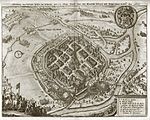Siege of Pilsen (1433–1434)
1433 in Europe1434 in EuropeBattles in BohemiaBattles of the Hussite WarsConflicts in 1433 ... and 5 more
Conflicts in 1434History of the Plzeň RegionPlzeňProkop the GreatSieges involving the Holy Roman Empire

The siege of Pilsen lasted from 14 July 1433 to 9 May 1434 and was an important encounter of the Hussite Wars. Hussite troops led by Prokop the Great had unsuccessfully besieged the Catholic city of Pilsen for nine months and twenty three days. Failure to capture one of the last major Catholic cities in Bohemia along with the fall of New Town was a huge blow for the Hussite groups that foreshadowed their decisive defeat in the Battle of Lipany.
Excerpt from the Wikipedia article Siege of Pilsen (1433–1434) (License: CC BY-SA 3.0, Authors, Images).Siege of Pilsen (1433–1434)
Křižíkovy sady, Pilsen Vnitřní Město
Geographical coordinates (GPS) Address Nearby Places Show on map
Geographical coordinates (GPS)
| Latitude | Longitude |
|---|---|
| N 49.746666666667 ° | E 13.379444444444 ° |
Address
Křižíkovy sady
301 12 Pilsen, Vnitřní Město
Southwest, Czechia
Open on Google Maps










